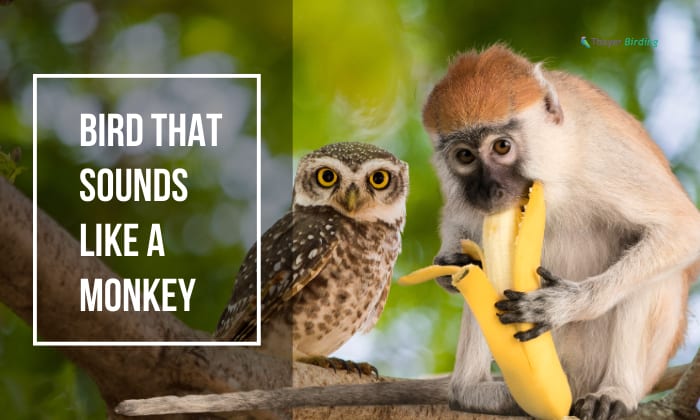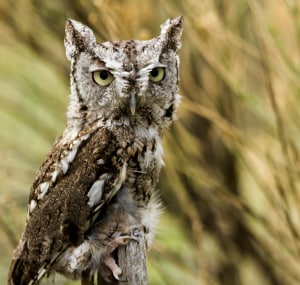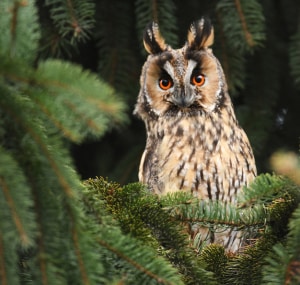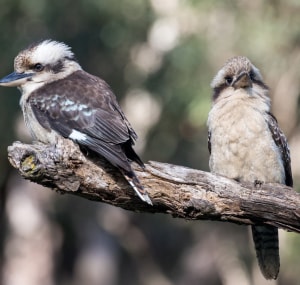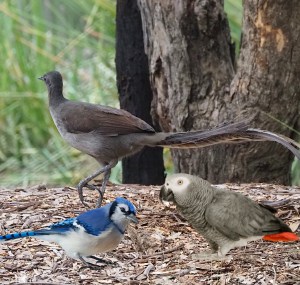Bird watching is a popular hobby for a reason. The feathered, flying animals come in all shapes, sizes, and colors and can be found in various habitats and at times of the day. They also make such a wide variety of exciting sounds!
While most people know birds chirp, whistle, and sing, some have more distinct sounds.
What is a bird that sounds like a monkey? Owls! Look out for the Barred Owl, Screech Owl, and Great Horned Owl, among others. Another monkey-sounding bird species is the Laughing Kookaburra from Australia.
Table of Contents
Birds That Sound Like a Monkey
Birds are very vocal animals, frequently using sounds to communicate with each other. Some sing beautiful songs, some scream, while others can mimic different sounds exceptionally well, including human voices.
However, enthusiasts have noticed that a specific bird group has a call similar to another animal altogether–monkeys!
Here are eight bird that sounds like a laughing monkey.
1. Barred owl
At the top of the list of owl that sounds like a monkey are Barred Owls.
This common North American bird got its name from the white bars on its brown feathers. Barred owls are relatively big birds, between 16 to 25 inches long, with a broad wingspan of up to 60 inches.
While they don’t precisely chuckle like apes, a barred owl sounds like a monkey due to its deep, hooting voice.
2. Western screech owl
There are two varieties of screech owls across the United States: the eastern and western screech owl. Both are small owls between six to ten inches long.
The eastern bird makes a trilling, descending whinny, more like a horse than a monkey. However, this Michigan bird’s cousin from the west produces “bouncing” hoots that sound distinctly monkey-like.
3. Great horned owl
Great horned owls are massive northeast bird with a wingspan of four and a half feet! Their name comes from the two “horns” on their head, which are just standing tufts of feathers.
Like the barred owl, this Florida bird and Wisconsin bird has deep hoots. However, their true monkey-ness is audible in the higher-pitched cries of female and young birds.
4. Barn owl
Barn owls have heart-shaped faces and are one of the few owl species that hunt during the day, though they are still primarily active at night.
This Minnesota bird enjoys living around farmlands and doesn’t hoot–it screams. And its scream is eerily similar to one of an angry monkey!
5. Long-eared owl
Long-eared owls are often confused with great-horned owls because of their long ears, but side by side, they are simple to tell apart: long-eared owls are smaller and slimmer.
Long-eared owls can be found worldwide and are usually between twelve to fifteen inches long, with an average wingspan of forty inches.
It has two calls: a high-pitched begging cry and a mischievous-monkey-sounding “Eeee!” call.
6. Laughing kookaburra
What tropical bird do we hear when watching Hollywood movies in the jungle? The laughing kookaburra!
The kookaburra is an Australian bird whose call has been used in numerous movies to give the illusion of monkeys, from Tarzan to Indiana Jones. As its name suggests, its bird call sounds like laughing.
7. Peacock
What bird sounds like a monkey aside from owls and the kookaburra? Peacocks!
Male peacocks are known for being loud and vocal, particularly when trying to attract a mate.
One of the sounds they make is a “keh-keh” or “ah-ah” sound, similar to a monkey’s laugh.
8. Mimicking birds
While some birds naturally sound like monkeys, some merely copy them. Certain species have the skill of imitating any sound they hear, from human voices to construction sounds.
Some birds that have been observed to mimic monkeys or the birds that sound like monkeys include
- Blue Jays
- Lyrebird (imitating a laughing Kookaburra), and
- Parrots
Why Do Owls Sound Like Monkeys?
The first thing to note is that owls don’t intentionally sound like monkeys, like what some of the mimicking birds might be doing.
The “monkey sound” owls produce is part of their regular owl song composed of hoots and “hooo-aawwws,” similar to a monkey’s laugh.
Owls are known for piercing screeches when they aren’t singing or hooting.
Tips for Watching Owls
As great as online recordings are, nothing beats hearing sounds an owl makes in person. Here are a few tips for watching owls:
- Learn about the owls in your area: There are websites such as OwlsNearMe.com that can help you with this!
- Be quiet and patient: Owls have excellent hearing and will not approach if they know someone is there. Make sure to mute your digital devices and stay as still as possible to avoid the rustle of clothing.
- Look and listen carefully: Owls have natural camouflage that protects them from predators–and curious humans. Even if you aren’t moving, keep your ears and eyes sharp for any sounds and movements that give away the presence of owls.
- Don’t shine a spotlight on the bird: When you spot an owl, don’t shine your flashlight directly on it. This may startle it or cause it to attack you. Instead, point somewhere and allow indirect light to reveal the bird.
- Keep your distance: As tempting as it is, avoid approaching the owl. Many owls are aggressive and may react negatively if you come near them. Enjoy their plumage and sounds from afar for safety.
Conclusion
Think again the next time you hear an “ooh-ooh-aah-aah” in the trees or a movie. Are you genuinely hearing a monkey or a bird that sounds like a monkey?
Nature is full of exciting sounds, smells, and sights that we can enjoy by simply opening our eyes and ears and paying attention.
We don’t even need to go far to do it either. If you aren’t a regular birdwatcher, you can begin by getting to know the birds in your yard. Do you already know all their names and calls?
Top lists that people are interested in:

George and I became friends after a birdwatching trip with our new group. And we have been enjoying every adventure together. When he told me the idea of establishing a site that shares our experiences and fun, I immediately agreed. After trials and errors, here we have Thayerbirding.


